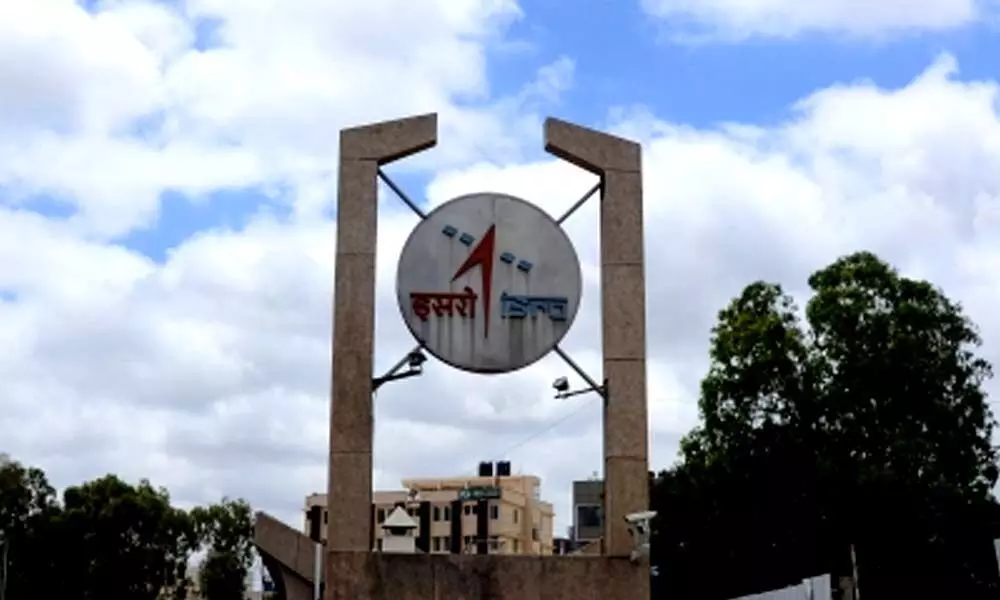Live
- Why plant-based milks may not be healthy
- Jharkhand: Ayushman Bharat cards in demand, Sahebganj residents rush to the centre
- Supreme Court likely to pass directions on implementation of policy to curb air pollution in Delhi-NCR tomorrow
- The first day of Group-2 Paper 1, 2 exams in Wanaparthy district ended peacefully, said Additional Collector Revenue G. Venkateswarlu
- VP Dhankhar urges corporates to invest in education
- Punjab DGP, MHA official request farmer leader Dallewal to end 20-day fast
- Stage Collapse During Swearing-In Ceremony of KUDA chairman in Kakinada
- Govt unveils ‘Jalvahak’ to boost inland waterways
- List of criminals: Delhi BJP chief on AAP panel of 38 candidates
- PSBs in India clock record Rs 1.41 lakh crore in net profit in FY24
Just In
ISRO to orbit Indo-French satellite, eight others on Saturday


ISRO (Indian Space Research Organisation) (Photo/IANS)
The Indian space agency is gearing up to orbit Earth Observation Satellite-6 (EOS-6) with a French payload, a third generation satellite in the Oceansat series, and eight other nano satellites on Saturday morning.
Chennai: The Indian space agency is gearing up to orbit Earth Observation Satellite-6 (EOS-6) with a French payload, a third generation satellite in the Oceansat series, and eight other nano satellites on Saturday morning.
Out of the nine satellites that will be carried by the Indian Space Research Organisation's (ISRO) rocket Polar Satellite Launch Vehicle (PSLV-C54), EOS-6 will be the primary passenger while the others are piggybacks.
The piggybacks include satellites from two Indian startups - Syzygy Space Technologies Pvt Ltd, commonly known as Pixxel (Anand-16.51 kg), and Dhruvaspace's two Thybolt satellites - 1.45 kg, Spaceflight USA's Astrosat (four numbers 17.92 kg) and ISRO's INS-2B (18.28 kg).
Other than EOS-6 and INS-2B, all other satellites will be carried for a fee. The commercial transaction was structured by NewSpace India Ltd (NSIL), a senior ISRO official told IANS.
According to ISRO, the EOS-6/Oceansat will provide continuity services of Oceansat-2 spacecraft with enhanced payload capabilities and application areas.
The 1,117 kg EOS-6 payloads include Ocean Color Monitor (OCM-3), Sea Surface Temperature Monitor (SSTM), Ku-Band Scatterometer (SCAT-3) and ARGOS - a French payload.
According to France, ARGOS will reinforce the existing fleet of Indo-French satellites working on weather surveillance that are already in orbit (MEGHA-TROPIQUES and SARAL-ALTIKA), thus enhancing contributions related to the objectives of the Paris Agreement.
The ISRO said the satellite will ensure data continuity of ocean colour and wind vector data to sustain the operational applications. It will also improve the applications, some additional datasets such as Sea Surface Temperature and more bands in Optical region for fluorescence and in Infrared region for atmospheric corrections are accommodated.
The satellite will also develop/improve related algorithms and data products to serve in well established application areas and to enhance the mission utility.
The INS-2B is ISRO's second nano satellite for Bhutan with two payloads viz., NanoMx and APRS-Digipeater.
According to ISRO, NanoMx is a multispectral optical imaging payload developed by its Space Applications Centre (SAC). The APRS-Digipeater payload is jointly developed by DITTBhutan and ISRO's UR Rao Satellite Centre (URSC).
The Anand nano satellite is a technology demonstrator to demonstrate the capabilities and commercial applications of miniaturized earth-observation camera for earth observation using a microsatellite in Low Earth Orbit. This is a three-axis stabilised satellite consisting of a satbus, accommodating all subsystems like telemetry, tele-command, electrical power system, Attitude Determination and Control System (ADCS), on-board computers and others and a payload unit, ISRO said.
The Thybolt has a communication payload to enable rapid technology demonstration and constellation development for multiple users. It also demonstrates Store-and-Forward functionality for authorised users in the amateur frequency band.
The satellites shall be deployed by using Dhruva Space Orbital Deployer to perform the specific mission operations for a minimum lifetime of one year.
Astrocast, a 3U spacecraft, is a technology demonstrator satellite for the Internet of Things (IoT) as the payload.
The Indian space agency will use its XL variant of its four staged PSLV rocket that stands 44.4 metre tall and weighs 321 tonne. The rocket will fly away from the first launch pad in the Sriharikota rocket port in Andhra Pradesh.
According to ISRO, the PSLV-C54 will orbit the EOS-6 and the eight small satellites in two different sun synchronous polar orbits (SSPO).
The rocket is expected to lift off at 11.56 a.m. on Saturday.
About 17 minutes into the flight the rocket will first eject EOS-6. Then the orbit will be changed by using two Orbit Change Thrusters introduced in the rocket's propulsion bay ring. The piggyback passengers will be separated in Orbit-2.

© 2024 Hyderabad Media House Limited/The Hans India. All rights reserved. Powered by hocalwire.com






